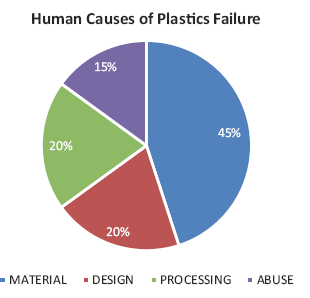Practical Adherence to Design Rules – a Matter of Choice? Part 2
Part 1 Summary
This is a continuation of the discussion from part 1. Let us start with a quick summary:
Unlike metals, plastics are not capable of withstanding long-term stresses. A significant number of failures occur due to long term stresses. These long-term stresses can result from:
- Willful disregard of this inherent characteristics of the materials
- Lack of knowledge of the characteristics
- As a result of poor choice of
- Materials
- Design (non-observance of design rules)
- Tooling errors
- Poor processing
In his book, Failure of Plastics and Rubber [1], David Wright conducted an analysis on 5,000 failed parts and came up with the causes for the failures shown in Figure 1.

Figure 1 – Causes of plastics failure [1]
In my opinion, however, failures due to design deficiencies may be the cause of most of them and sometimes mistakenly attributed to the other three causes.
As an example, in part one we discussed the loss of chemical resistance due to inherent or applied stresses and failures due to sharp internal corners. Other examples of sharp internal corners showed reduction in both the chemical resistance and mechanical strength. These would ordinarily be labeled as material failures or the material being a significant contributor.
Now let us classify the failures and use some real examples to drive home the point.
Failures can be broadly classified into:
- Catastrophic failures
- Major failures leading to injury, recalls and serious revenue loss
- Failures leading to loss of revenue, reputation and customer base
- Failures giving plastics a bad name
Before we get into the specifics, let us remember that most of plastic parts perform four functions:
- Exposed parts that mostly enhance the aesthetic appeal. Some examples are cell phone housings, cosmetics cases, automotive exterior and interior parts, etc.
- Enclosures that need to be
- cosmetically appealing
- be robust and not fail in normal handling and occasional accidents such as being dropped from a short height
- protect the inner parts and mechanisms including such delicate items as displays and electronic circuit boards
Some example are land line phones, TV remote controls, hand held computing devices, portable drills, etc.
- Exposed functional parts such as levers, handles, cutlery, etc. They need to:
- be cosmetically appealing
- not fail during the performance of their function
- Interior parts or external parts not subject to direct viewing. Some examples are internal printer parts, bottom covers of printers or other non-portable equipment, etc.
Let us discuss some examples for the above-mentioned failure classification in reverse order:
Failures that give plastics a bad name
Give a dog a bad name and (one may as well) hang him…
“…. Mackenzie (Jason Mackenzie, president, HTC Americas) says that if you want cheap plastic, the Samsung Galaxy S5 is for you. “But we’re going after a different customer,” says the executive, “someone who wants the best…” [7]
Cheap plastic? Really?
Imagine a world without plastics today.
I hope the reader agrees that plastics are amazing materials with unique properties that complement and supplement metals and even surpass them in many areas such as impact, energy absorption, insulation, transparency, visuals, cost, light weight, etc.
Aluminum, as an example, is also an extremely important material. But imagine aluminum being exposed to salty water for even a short-sustained period.
Figure 2 is an aluminum, tray I picked up from the street a few weeks after a snow storm. The road was sprayed with a lot of salt. Look at what the salt solution did to the tray.
Cheap aluminum?

Figure 2
The following examples fall into the branding “plastics as cheap” category:
Figure 3 shows a broken handle on a rather expensive blind. Cause – sharp internal corner.

Figure 3

Fig 4
Figure 4 shows a common ballpoint pen with a broken clip. Cause of failure – sharp internal corner with continuous strain (the clip being kept in a “stretched” position for an extended period).
Figure 5 shows a broken plastic tong. Cause gate located at an area subjected to high stress.

Figure 5
Figure 6 shows a polystyrene stirrer with ugly void marks in the thin section. Cause of failure – flow of plastic from thick to thin (and not being able to be packed).

Figure 6
Figure 7 shows a cell phone cover with ugly sink and flow marks. Cause of failure – ribs being too thick, and gate being located on a thin wall.

Figure 7
Figure 8 shows cracks around the screw on a blow dryer. Cause – continuous hoop stress on the hole due to the flat head screw.

Figure 8
I will conclude part two with a bumper sticker below that just made so much sense to me.

The customer may not know what causes voids in a plastic stirrer. But she knows that it is a defect.
Given the competitive state of the market, she will find ones that do not have this blemish.
And may never come back!
In future blogs, we will discuss the other failure classifications.
Please be sure to attend a detailed paper on the subject at the Society of Plastics Engineers ANTEC Conference in Orlando, FL, USA on Thursday, May 10 at 4:00 PM presented by Vikram Bhargava and Rahul Rajadhayksha with actual parts and a demonstration.
References:
[1] Modified from D. Wright; Failure of Plastics and Rubber Products, Smithers Rapra (2001) p. 6
[2] Associated Press, April 1, 2014
[3] CNN Money
[4] Photographs and excerpts from V. Bhargava; Robust Plastic Product Design: A Holistic Approach, Hanser Publishers, Munich
[5] caoc.org
[6] Samsung’s devices are for those who want cheap plastic, says HTC’s Mackenzie
Never Miss an Update
Subscribe to the HCL DFMPro Blog weekly digest
and stay informed about the latest content from industry leaders.